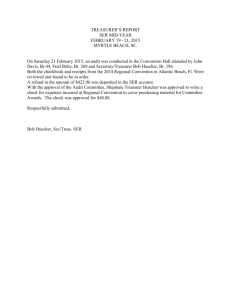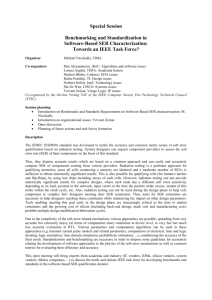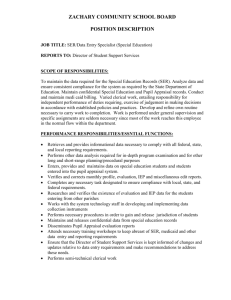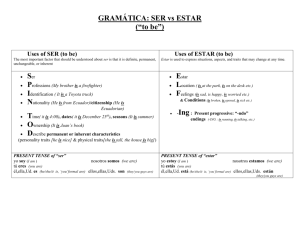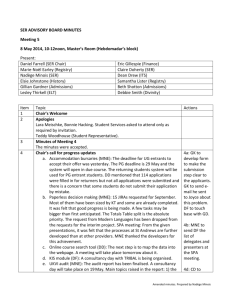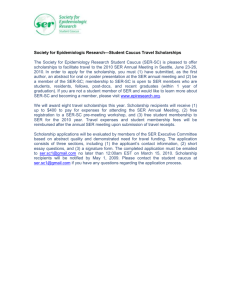Part 1 GENERAL - Schneider Electric
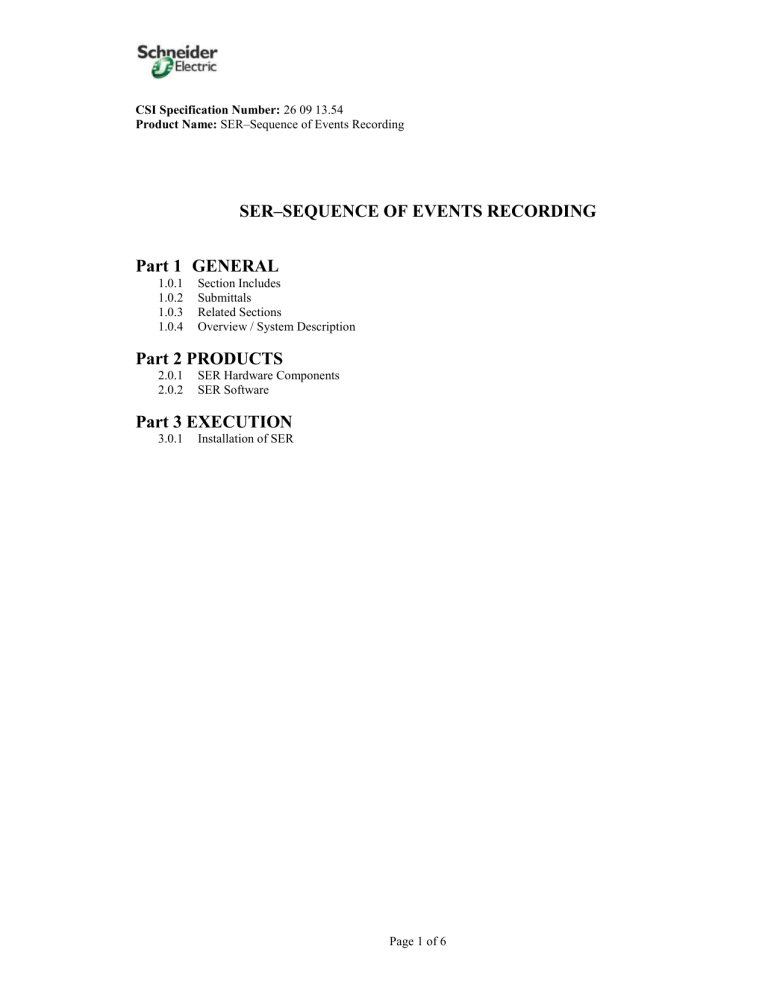
CSI Specification Number: 26 09 13.54
Product Name: SER–Sequence of Events Recording
SER–SEQUENCE OF EVENTS RECORDING
Part 1 GENERAL
1.0.1
Section Includes
1.0.2
Submittals
1.0.3
Related Sections
1.0.4
Overview / System Description
Part 2 PRODUCTS
2.0.1 SER Hardware Components
2.0.2
SER Software
Part 3 EXECUTION
3.0.1
Installation of SER
Page 1 of 6
CSI Specification Number: 26 09 13.54
Product Name: SER–Sequence of Events Recording
SER–SEQUENCE OF EVENTS RECORDING
PART 1 GENERAL
1.01
SECTION INCLUDES
A.
This section describes requirements for Sequence of Events Recording (SER). The Sequence of
Events Recording system shall gather hardware and software events from equipment and stores the data into a database for viewing and analysis. The system is useful for troubleshooting problems that may occur at a complex or campus. The goal of SER is to have a system-wide, computerized event log that presents a list of events, ordered and categorized by various attributes, such as time-stamp, priority, name of equipment being monitored, etc.
1.02
SUBMITTALS
A.
Shop Drawings.
The drawings shall be provided on a job-by-job basis.
B.
Product Data . Catalog sheets shall indicate function and data performance.
C.
Instruction Bulletins . Instruction bulletins shall provide technical information on the installation, use, and operation of the Sequence of Events Recording hardware components and software module.
1.03
RELATED SECTIONS
A.
N/A.
1.04
OVERVIEW / SYSTEM DESCRIPTION
A.
System-wide Faults in Electrical Power Systems.
Sequence of Events Recording (SER) Systems have been used in the electrical power industry for some time to facilitate “root-cause-analysis.”
A “root-cause-analysis” is a post-mortem analysis of system-wide faults in an electrical power system. Electrical disturbances may cause a cascade of tripped circuit breakers and protective relays at various points in an electrical power system. When an electrical outage occurs, it may take many hours to determine the exact cause of the fault, if ever. The electrical power system may not even be put back online until the cause of the fault is determined. The amount of time needed to determine the cause and location of the fault is compounded by several factors:
The physical size of a facility or complex
The amount of low, medium, or high voltage equipment in the system
The availability and quality of procedures describing how to bring the system back online
All of these factors can lengthen the time to identify the cause of the fault.
B.
One-millisecond Time Stamping for Root-Cause-Analysis.
Time stamping events is of little use in a “root-cause-analysis”, if it fails to identify the actual sequence of events. Many events can occur within the same second, but their occurence may differ when compared in milliseconds. Given that electrical faults travel as fast as 186,000 miles per second, one-millisecond time-stamping is necessary to make the event record useful. The status from each piece of critical power distribution equipment, such as a circuit breaker or a protective relay, should be hard-wired into the SER system, using global positioning satellite system (GPSS) clocks to generate the precise time reference, with an accuracy of better than one millisecond.
C.
Use of Deterministic Clock Signals to Resolve Drifitng Clock Time.
Electronic components, transmitting deterministic clock signals, such as IRIG-B and DCF77, can provide accurate time references, with fidelity of one millisecond or less. Components, such as automated monitoring
Page 2 of 6
CSI Specification Number: 26 09 13.54
Product Name: SER–Sequence of Events Recording devices and meters, with deterministic clocks, can eliminate or can greatly reduce the problem of drifting clock times.
D.
System Fidelity.
The following specifications shall be met to maintain the fidelity of an SER system.
1.
Clocks with no more than 1 millisecond accuracy and resolution, including time drift
2.
Equipment to provide adequate identification of equipment or components being monitored
3.
Equipment to provide adequate descriptions of events
4.
A single SER system data log to store events
E.
Hardware.
The hardware is to be an integrated collection of devices and components that record, receive, and capture two-state events, and synchronized time stamps, with an accuracy of one millisecond. The hardware may include …
GPS Antennas
Satellite Time Reference Modules
Electronic Clocks
Clock Signal Hardware
Stand-Alone Input Modules, Event Recorders
Power and Circuit Monitors
Multifunctional Protective Relays
Solid State Specialty Trip Indication Relays
Power Supplies
Data Network Components
Enclosures
Computer Hardware
F.
Software.
The software shall provide a log of events, viewable from a web-base client. SER software shall limit the access and viewing of logged events, by using a security scheme. The presentation of events may be sorted and filtered based upon event attributes. The software shall be a real-time service, collecting SER events from a data network. It shall store the events in a system-dedicated database. Each event, captured by the software, shall have a time stamp, having an accuracy/resolution of one millisecond.
PART 2 PRODUCTS
2.01
SER HARDWARE COMPONENTS
A.
The SER system shall have electronic, automated monitoring devices and meters to monitor and collect the event statuses of low, medium, and high voltage equipment in a critical power distribution system. The electronic, automated monitor devices and meters shall have the following:
1.
Synchronized clocks with drifts of less than one millisecond. (The clocks may have specialized cards with the appropriate hardware/firmware to decode deterministic clock signals, such as IRIG-B, DCF77, and 1per10.)
2.
Onboard data logs for storing the event statuses
3.
Modbus RTU or Modbus/TCP interface for communication with an SER software system.
4.
Discrete inputs, sending incoming DC (Direct Current) electrical signals, representing discrete statuses of voltage equipment. Components shall sample and record the discrete states of voltage equipment as DC electrical signals to the SER electronic, automated monitoring devices and meters.
Page 3 of 6
CSI Specification Number: 26 09 13.54
Product Name: SER–Sequence of Events Recording
B.
Medium voltage circuit breakers in an SER system shall have trip indication relays (TIR) hardwired in series with the trip coils. Each solid-state relay shall be inserted between the MV protective relay and the trip coil in each medium voltage breaker. The output contacts on the TIR shall be hardwired to an electronic, automated monitoring device or meter (such as a
PowerLogic® Circuit Monitor 4000 or a CyTime SER-3200 Event Recorder from Cyber Sciences.
Time stamps for medium voltage breakers shall be for the beginning and completion of breaker trips. The TIR shall energize when the shunt trip coil energizes. The TIR shall release when the shunt trip coil de-energizes. The electronic, automated monitor device or meter shall make accessible the breaker trip information with time stamps (1 ms accuracy) to the SER software system, using a Modbus RTU or Modbus/TCP interface and onboard data logs. The electronic, automated monitor device or meter shall access the circuit breaker statuses via “a” and/or “b” contacts. The SER monitor devices shall make accessible the following medium voltage breaker statuses with time stamp (1 ms accuracy) to the SER software system, using a Modbus RTU or
Modbus/TCP interface and onboard data logs:
1.
Trip coil relay (interfaced via trip indication relay)
2.
Operator open indication
3.
Operator close indication
4.
Trip indication
C.
For medium voltage protection relays in an SER system, the SER monitor devices shall make accessible the ANSI numbers and event descriptors with time stamp (1 ms accuracy) to the SER software system, using a Modbus RTU or Modbus/TCP interface and onboard data logs.
D.
For multifunction electronic relays in an SER system, the SER monitor devices shall make accessible ANSI function codes or events with time stamp (1 ms accuracy) to the SER software system, using a Modbus RTU or Modbus/TCP interface and onboard data logs.
E.
For an electronic, automated monitoring device having oscilographic capability, the time stamps
(1ms accuracy) of the oscilographic functions shall match the events that initiated the waveform capture. PowerLogic® Circuit Monitor series 4000 is an example of an electronic, automated monitoring device having oscilographic capability.
F.
Low-voltage circuit breakers in an SER system shall be hard-wired via bell alarm and auxiliary contacts. SER monitoring devices shall make accessible the following low-voltage breaker statuses with time stamp (1 ms accuracy) to the SER software system, using a Modbus RTU or
Modbus/TCP interface and onboard data logs:
1.
Open/Close indication
2.
Normal/Tripped indication
G.
Stand-alone Sequence of Events Recorders. For high-speed event recording of all discrete status inputs, stand-alone 32-input modules shall be used, type CyTime SER-3200 Sequence of Events
Recorders from Cyber Sciences. Key features shall include:
1.
GPS time sync input via unmodulated IRIG-B or inter-device sync (IRIG-B over RS-485)
2.
32 high-speed digital inputs with configurable filter, debounce and chatter functions per input channel, as well as configurable trigger output to enable coincident waveform capture, etc.
3.
Event log to store at least 8000 events, accessible from multiple masters; each event record shall contain descriptive information for root-cause analysis, such as time/date stamp, input number, event type, input status, time quality and unique sequence number.
4.
Ethernet network interface supporting Modbus TCP/IP and embedded web server for setup and monitoring. Custom web pages may be added at any time for further customization.
5.
All setup and event data shall be stored in non-volatile memory; a built-in, standard SD flash memory card shall store user setup values and also be accessible over the network to provide distributed storage of user files, such as instruction bulletins, equipment drawings, etc.
Page 4 of 6
CSI Specification Number: 26 09 13.54
Product Name: SER–Sequence of Events Recording
2.02
SER SOFTWARE
A.
System-level Sequence of Events Recording (SER) software shall run as a real-time service, automatically initiated by a supporting electronic, automated processing or computer system.
B.
The module shall support Modbus/RTU or Modbus/TPC communications to access logged events from SER monitor devices.
C.
The module shall have a web-based client for setup and viewing.
D.
Shall have its own dedicated, stand-alone database, such that it is used for storing system configuration data, information about the monitoring devices, event logs, and system diagnostic data.
E.
Shall recognize and communicate with electronic, automated monitoring devices or meters that monitor, collect, and log event statuses from equipment, as specified in section 2.01, “SER
Hardware Components”. The following are some examples of SER monitoring devices that the
SER software system may communicate with:
1.
PowerLogic® Circuit Monitor series 4000
2.
PowerLogic Power Meters, series 800
3.
Sepam protection relays, series 20, 40, 80
4.
General Electric Multilin® 489, 745, & 750/760
5.
CyTime SER-3200 Sequence of Events Recorders from Cyber Sciences
F.
Shall implement a software feature for assigning administrative and user groups in relation to access rights of system setup and maintenance and data viewing and printing.
G.
Shall not poll devices if one of the following conditions exist:
1.
SER device out-of-service
2.
Communication Loss
H.
Shall collect, at a minimum, 350 events per minute, from multiple devices:
I.
Shall have an event log for users to view events, logged by various SER-recognizable monitor devices.
J.
Shall have the following event attributes for viewing in an event log:
1.
Data/Time Stamp w/1ms Resolution
2.
Quality of Date/Time Stamp
3.
Event Description
4.
State/Value
5.
Priority
6.
Name of Equipment or Component Being Monitored (such as circuit breaker or relay switch)
7.
Event Locality (Location of Monitored Equipment or Component)
K.
Shall be able to sort events in an event log, using the following event attributes as sorting keys:
1.
Data/Time Stamp w/1ms Resolution
2.
Quality of Date/Time Stamp
3.
Priority
4.
Event Description
5.
State/Value
6.
Name of Equipment or Component Being Monitored (such as circuit breaker or relay switch)
7.
Event Locality (Location of Monitored Equipment or Component)
L.
Shall be able to filter events in an event log, using the following event attributes:
1.
Time Range Using Date/Time Stamps
2.
Quality of Date/Time Stamp
3.
Priority
4.
Event Description
Page 5 of 6
CSI Specification Number: 26 09 13.54
Product Name: SER–Sequence of Events Recording
5.
State/Value
6.
Name of Equipment or Component Being Monitored (such as circuit breaker or relay switch)
7.
Event Locality (Location of Monitored Equipment or Component)
M.
Shall print a report of any filtered or sorted events from an event log, both browser and formatted print.
N.
Shall have a system diagnostic log for users to view device progress points, events, and errors relating to the health and status of the SER system and its monitoring devices.
O.
Shall have the following system diagnostic message attributes for viewing in a system diagnostic log:
1.
Date/Time Stamp with 1 ms Resolution
2.
Message Type – Progress Point, System Event, or Error
3.
Message
P.
Shall be able to sort system diagnostic messages in a system diagnostic log by date and time.
Q.
Shall be able to filter system diagnostic messages in a system diagnostic log by the following attributes:
1.
Time Range with Using Data/Time Stamps
2.
Message Type – Progress Point, System Event, or Error
R.
Shall print a report of any filtered or sorted system diagnostic messages from a system diagnostic log, both browser and formatted print.
S.
Shall have upgrades that are backward compatible.
T.
Shall have an export utility to upgrade older versions of the SER system.
U.
Shall have instruction bulletins to guide the user in the installation and operation of SER.
V.
Shall have graphical user interface (GUI) screens, with Help Context, providing descriptive information to the user on installing or operating SER.
PART 3 EXECUTION
3.01
INSTALLATION OF SER
A.
The contractor, as designated by the customer, shall wire and mount all SER monitoring devices according to the drawings and literature, as provided by the customer and the manufacturers.
B.
The contractor, as designated by the customer, shall setup the SER software system, using the manufacturer’s instruction bulletins for assistance and as a guide.
C.
The contractor shall test the SER hardware and software system to ensure that it is fully functional and operational. Successful test shall be where the user can view the event logs of all equipment or components being monitor and can sort, filter, and print the event logs.
END OF SECTION
Page 6 of 6
